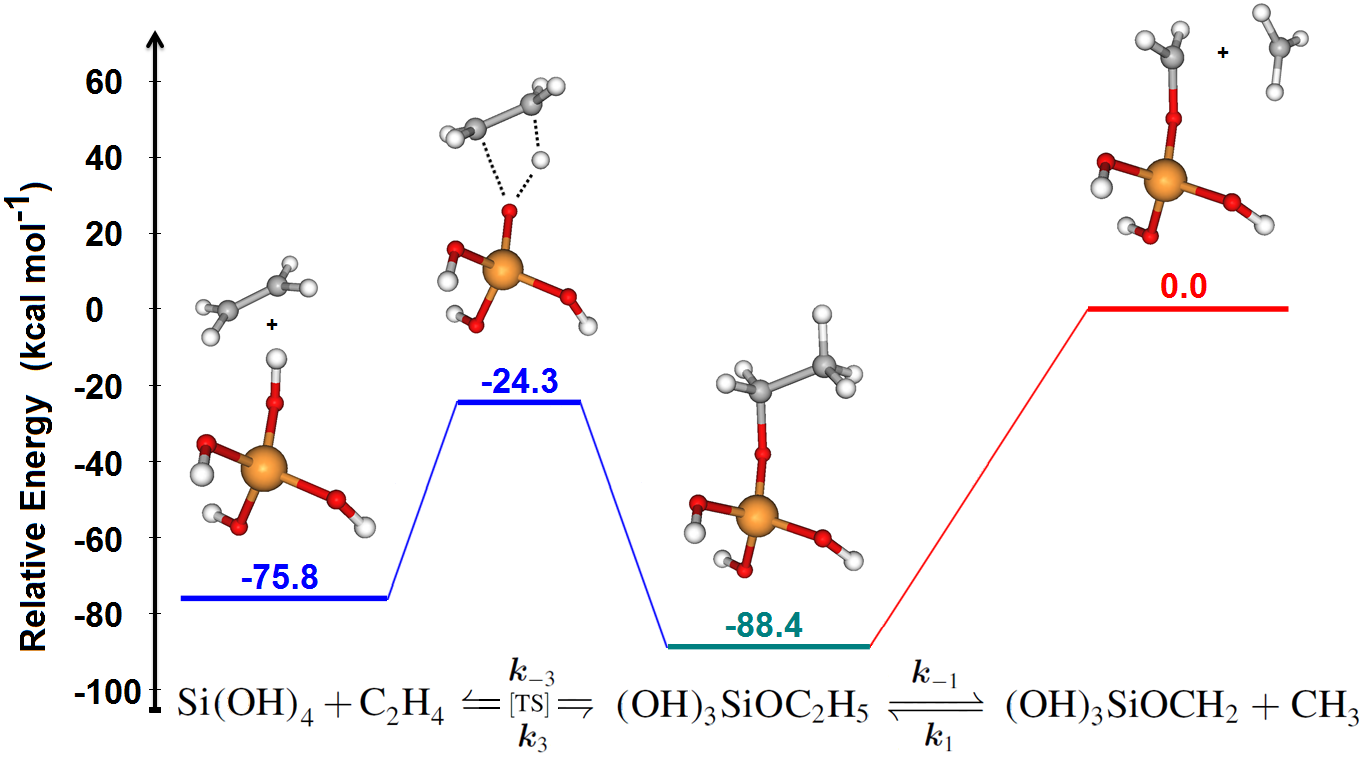Ab initio Variational Transition State Theory and Master Equation Study of the Reaction (OH)3SiOCH2 + CH3 <-> (OH)3SiOC2H5
- A detailed study of the kinetics of the title reaction is presented.
- Variable reaction coordinate transition state theory and master equation calculations are used to obtain rate constant coefficients at various pressures and temperatures.
- A comparison is made with an equivalent ethanol reaction computed at the same level of theory.
 In this paper we use variable reaction coordinate variational transition state theory (VRC-TST) to calculate the reaction rate constants for the two reactions, R1: (OH)3SiOCH2 + CH3 <-> (OH)3SiOC2H5, and R2: CH2OH + CH3 <-> C2H5OH. The first reaction is an important channel during the thermal decomposition of tetraethoxysilane (TEOS), and its rate coefficient is the main focus of this work. The second reaction is analogous to the first and is used as a basis for comparison. The interaction energies are obtained on-the-fly at the CASPT2(2e,2o)/cc-pVDZ level of theory. A one-dimensional correction to the sampled energies was introduced to account for the energetic effects of geometry relaxation along the reaction path. The computed, high-pressure rate coefficients were calculated to be, R1: k1 = 2.406 * 10 -10 T-0.301 exp(-271.4/T)cm3 molecule-1 s-1 and R2: k2 = 1.316 * 10-10 T-0.189 exp-256.5/Tcm3 molecule-1 s-1. These rates differ from each other by only 10% − 30% over the temperature range 300 − 2000K. A comparison of the computed rates with experimental data shows good agreement and an improvement over previous results. The pressure dependency of the reaction R1 is explored by solving a master equation using helium as a bath gas. The results obtained show that the reaction is only weakly pressure dependent over the temperature range 300 − 1700K, with the predicted rate constant being within 50% of its high-pressure limit at atmospheric pressure.
In this paper we use variable reaction coordinate variational transition state theory (VRC-TST) to calculate the reaction rate constants for the two reactions, R1: (OH)3SiOCH2 + CH3 <-> (OH)3SiOC2H5, and R2: CH2OH + CH3 <-> C2H5OH. The first reaction is an important channel during the thermal decomposition of tetraethoxysilane (TEOS), and its rate coefficient is the main focus of this work. The second reaction is analogous to the first and is used as a basis for comparison. The interaction energies are obtained on-the-fly at the CASPT2(2e,2o)/cc-pVDZ level of theory. A one-dimensional correction to the sampled energies was introduced to account for the energetic effects of geometry relaxation along the reaction path. The computed, high-pressure rate coefficients were calculated to be, R1: k1 = 2.406 * 10 -10 T-0.301 exp(-271.4/T)cm3 molecule-1 s-1 and R2: k2 = 1.316 * 10-10 T-0.189 exp-256.5/Tcm3 molecule-1 s-1. These rates differ from each other by only 10% − 30% over the temperature range 300 − 2000K. A comparison of the computed rates with experimental data shows good agreement and an improvement over previous results. The pressure dependency of the reaction R1 is explored by solving a master equation using helium as a bath gas. The results obtained show that the reaction is only weakly pressure dependent over the temperature range 300 − 1700K, with the predicted rate constant being within 50% of its high-pressure limit at atmospheric pressure.
- This paper draws from preprint 147: Ab initio variational transition state theory and master equation study of the reaction (OH)3SiOCH2 + CH3 <=> (OH)3SiOC2H5
- Access the article at the publisher: DOI: 10.1515/zpch-2014-0640



